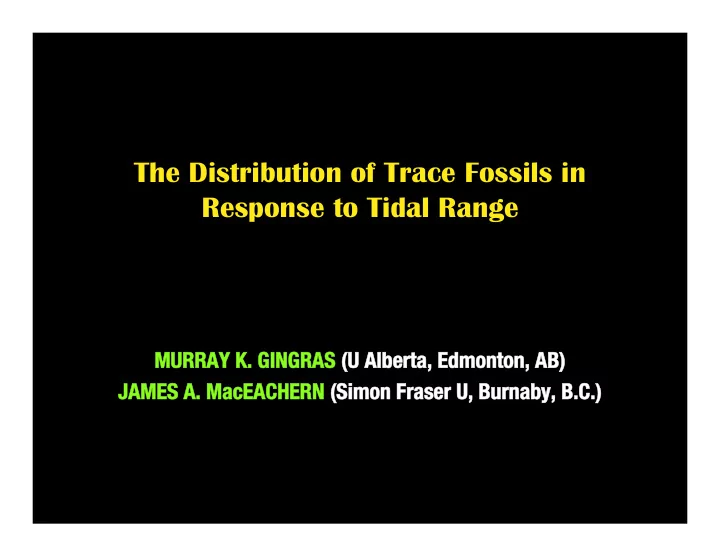

The Distribution of Trace Fossils in Response to Tidal Range MURRAY K. GINGRAS MURRAY K. GINGRAS (U Alberta, Edmonton, AB) (U Alberta, Edmonton, AB) JAMES A. JAMES A. MacEACHERN acEACHERN (Simon Fraser U, Burnaby, B.C.) (Simon Fraser U, Burnaby, B.C.)
Ongoing research in ancient and modern sedimentary systems is sponsored by: • Natural Science and Engineering Research Council of Natural Science and Engineering Research Council of Canada (NSERC) Canada NSERC) • BP BP (Bryan Ireland) Bryan Ireland) • Devon Energy Devon Energy (Dennis Dennis Meloche eloche) • Nexen Nexen Energy Energy (Dale Dale Leckie eckie) • Talisman Energy Talisman Energy (Dave Mundy, Gary Dave Mundy, Gary Labute abute, Jason Jason Lavigne avigne) • Petro Petro-Canada Canada (Richard (Richard Evoy voy) • ConocoPhillips ConocoPhillips (John (John Suter uter) • Imperial Oil Imperial Oil (Stan (Stan Stancliffe tancliffe) Special thanks to Special thanks to Dalrymple alrymple, Pemberton, and Pemberton, and Reinson einson.
SUMMARY • Trace fossil distribution is primarily a function of hydraulic energy (+ grain size) and water chemistry (primarily salinity and oxygenation). • Salinity and hydraulic energy change predictably in marginal-marine settings, primarily as a function of fluvial input and tidal range. • Hypothesis: the degree of tidal influence in a depositional environment can be assessed by the distribution of trace fossils.
Hydraulic conditions change predictably in estuaries. Dalrymple et al, 1992
The Energy Distribution in Estuaries Leads to: • In part determining whether or not an estuary will be vertically of laterally stratified. • Determining the residence time of water within estuaries. • Influencing the distribution of sediment grain sizes. • Influencing the location and breadth of the turbidity maximum.
The Influence of Tidal Range Tidal Range Nature of Water Nature of Stratificato Residence Grain n Time Distribution Microtidal More Months in Tripartite Vertically Inner Estuary stratified Mesotidal Seasonally Weeks in Inner Sand-rich into Variable Estuary Middle Estuary Macrotidal Laterally Days to Sand-rich with Stratified Weeks?? Muddy Bay Margins
Stratification in estuaries is a result of fresh water being more buoyant than salt water.
Where turbulence is increased due to high tidal exchange or as a result of meteoric storms, estuaries become less stratified.
Water retention in bays and estuaries results in lower landward salinity Willapa Bay and a reduction in the dissolved O 2 . changes about 40% of its water every tidal cycle!
If we make the statement that hydraulic energy mainly controls the distribution of trace fossils and chemistry mainly controls the size and diversity of trace fossils, we can make some good assumptions regarding the nature of trace fossil assemblages in bays and estuaries. Dalrymple et al, 1992
Dalrymple et al, 1992
Example of a predictive model: tide dominated.
Example 1: Willapa Bay • Upper mesotidal but wave-dominated. • Up to 43% of bay volume exchanged in a tidal cycle. • Shows a well defined salinity gradient once in inner estuary.
F(x) = diversity x diameter
F(x) = diversity x diameter
F(x) = diversity x diameter
F(x) = diversity x diameter
Example 2: Tillamook Bay • Mid-mesotidal: wave-dominated. • Up to 30% of bay volume exchanged in a tidal cycle. • Shows a well-defined salinity gradient only in inner estuary.
Example 3: Ogeechee Estuary • Lower-mesotidal: wave-influence minor. • Up to 25% of bay volume exchanged in a tidal cycle. • Has more notable fluvial input than Willapa or Tillamook. • Shows a well defined salinity gradient throughout estuary.
Ogeechee / Ossabaw Sound shows progressive increase in size and diversity basinwards. In general, bioturbation intensity is highest in the inner third of the estuary.
Example 4: Bay of Fundy in General • Macrotidal: wave-influence minor. • Huge tidal prism. • Fluvial inputs absolutely overwhelmed by tidal waters. • Salinity gradients minor, except in estuary arms.
High-energy tidal currents in the Bay of Fundy lead to a lack of burrowed facies except near bay margins and in sheltered flats.
A B B A
Essentially, no ichnological gradient is observed within bay. All the red zones shown below display the same ichnocoenose. The hatched area opens into marine conditions but is too energetic for much colonization to occur.
The Influence of Tidal Range Tidal Range Distribution Size of Trace Diversity of of Trace Fossils Trace Fossils Fossils Microtidal Follow Generally Generally Low Tripartite Small in Diversity in (not tested in Zonation, Middle Estuary Middle modern) Abrupt Estuary, Ichnofacies Impoverished Boundaries, or Absent in Mesotidal Mappable and Gradually Gradually Rarely Inner Gradational Decrease in Decrease in Burrowed Inner From Outer to Size Towards Diversity Est Inner Estuary Inner Estuary Towards Inner Estuary Macrotidal Little Unknown Generally Low Variation in due to Ichnofacies Hydraulic Reworking
Summary • Ichnofossils likely provide a means of determining the magnitude of tidal influence that a depositional setting was subject to. • In general, only mesotidal settings offer gradational ichnofacies subdivisions. • Microtidal should be mostly burrowed in the bay center—probably with sharp transitions demarcating the tripartite facies zonations. • Macrotidal estuaries show no obvious ichnological gradients. • The dataset needed to analyze a particular interval needs to be quite large.
Recommend
More recommend